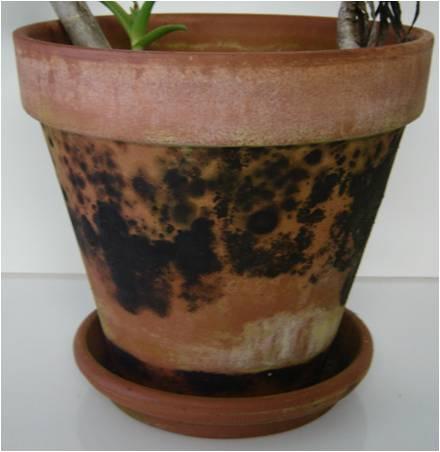
by Alex Bolques | Jul 28, 2015
Most likely, we all have them-garden pots. These typically are made of plastic, clay or wood. Garden pots should be sanitized if they were previously used or if they exhibit signs of mold or fungal growth. Whether they are used as garden boxes, planters, or hanging baskets, the surfaces of garden pots can harbor disease organisms, along with unsightly stains and mineral salts deposits. Salts from hard water and fertilizers can leach though clay pots leaving a white film on the pot’s outer surface. Salts accumulation can become flaky and encrusted around the rim and drainage holes of plastic and clay containers.

Mold or fungal growth on an unglazed terra-cotta (clay) pot Photo Credits: Alex Bolques, FAMU Research
To clean clay or plastic containers, use a brush or fine steel wool to remove dirt and debris and wash with a liquid soap detergent. If stains persist, consider using a 50:50 solution of water and vinegar. To sterilize clay or plastic pots, soak them in a mild solution of bleach, 1:10 bleach to water, for about 30 minutes. Then, immerse them in clean water and allow them to dry completely. Containers made of wood are different. If the timber that they are made of is not treated properly, they tend to rot and can harbor disease spores or bacteria. It is best to replace these as they show signs of wear or deterioration. Sanitizing your garden pots will help you avoid unwanted disease problems and unsightly garden container pots.
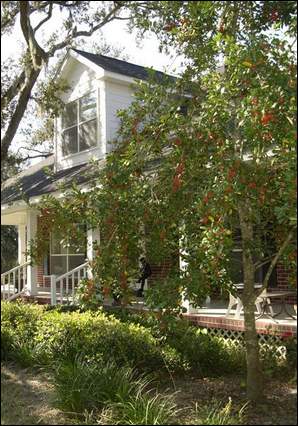
by Carrie Stevenson | Jul 27, 2015
Late summer brings hot, humid temperatures, and many Floridians are retreating from the heat into their air-conditioned homes. Unfortunately, those comforts of home also come with a price tag. When people think about energy efficiency, practices like turning off lights, purchasing energy-efficient appliances, good insulation and windows, and managing A/C temperature settings are the first things that come to mind. These are very important steps to take, not only to save money but also to conserve energy. The US Department of Energy has an excellent publication that can take you step-by-step through a home evaluation, and many energy companies offer a similar walk-through energy audit for free.
However, there are many best management practices that can be done outdoors to offset expensive home power bills. Planting trees is one example. Department of Energy studies have shown that when compared to a home in full sun, a shaded home may experience up to a 25% decrease in energy for cooling.
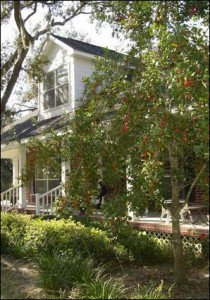
This home uses passive cooling from a front porch and numerous shade trees. Photo credit: Carrie Stevenson
Trees planted to shade eastern and western facing walls of your home can be the most effective, as these areas receive direct sun in the morning and afternoon. By preventing heat from entering your home, you prevent straining an air conditioning system that would otherwise have to counteract that heat. It is also helpful to provide shade over an air conditioning unit. Deciduous trees are ideal, as they have leaves to provide shade in the summer but drop them by winter, when you might want sunlight to passively heat your home.
In addition to shade, transpiration—the process of plants emitting moisture as they release water from leaf pores—creates cool spaces around vegetation. Grasses and shrubs along the edges of a home, or vines on nearby trellises, can cool walls and windows in this manner.
Finally, consider sprinkler systems. A home irrigation system can use a significant amount of energy to pump water throughout your yard. Calibrating your system and even reducing run time or frequency can also conserve water and reduce water bills.
For more information on energy-efficient landscaping, please visit www.myfloridahomeenergy.com or contact your local Extension office.
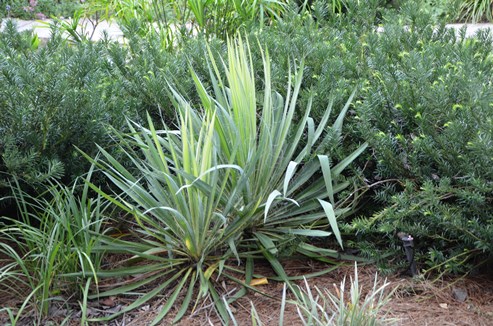
by Les Harrison | Jul 15, 2015

Native yuccas fit easily into the landscape without breaking the bank or the back of the gardener.
Being sharp is usually considered a complement. It implies the recipient of this assessment has the intellectual ability and the mental acuity to handle with ease the rigors of contemporary life.
In north Florida’s native plant world the yucca genus was sharp long before people employed it in landscapes. It also has the sharp pointy spines to enforce its tactics.
Local yuccas are perennial shrubs which can grow into small trees with a unique shape. There are approximately 50 species in this genus worldwide on every continent except Antarctica.
Their most obvious and notable feature which makes them easy to identify is their leaves. These are elongated in thick clusters around the stems.
The sword-like shape is tipped with a hardened point which can quickly get the attention of anyone passing too close. The bristly structure of these evergreen plants gives them an intimidating appearance which most animals and people avoid.
The annual blooms appear at the top of these plants and protrude above the greenery. Honeybees and other pollinators will visit the profusely fragrant bell-shaped flowers to collect nectar and pollen.
In their native range, these plants are seen in sites where there is high exposure to the sun. They will not grow in heavy shade, and languish with little change if there is less than six to eight hours of daily sun.
Sandy well drained soils are the most likely locations where yuccas will prosper and grow. Their nutrient requirement are low, so they rarely display symptoms of a nutrient deficiency.
Likewise, their need for water is paltry. Once established they will easily withstand droughts and extended dry periods.
The common species native to north Florida in this genus are Adam’s needles (Yucca filamentosa) and Spanish bayonets (Yucca aloifolia). These plants are similar in appearance, but each has distinctive traits.
Adam’s needles are the smaller and shorter of the two species. The multiple stems may reach three feet in height, but extend to over six feet when the cream color blooms appear in early summer.
The green leaves are pliable with white threads of fiber trailing from each. There is a variegated cultivar which is popular for landscaping projects.
Spanish bayonets produce multiple trunks per plant and may grow to over 15 feet. They produce rigid dark green leaves projecting from the thick trunks and will impale any trespasser.
White blossoms appear in the center of the plant above the foliage from spring to late summer depending on several weather related factors. These yuccas have a high salt tolerance making wild plantings common to coastal areas.
Disease and insect problems are few for these hardy plants. Too much water resulting in excessively wet roots and extreme cold are the biggest problems.
For the sharp homeowner these native plants make a pointedly good addition to the landscape.
To learn more about native yuccas in north Florida, contact the nearest UF/IFAS Extension office.

by Mary Salinas | Jul 7, 2015
Butterflies are not only beautiful to look at in your landscape; they serve as important pollinators and indicators of the health of our environment. Attracting them to your garden and incorporating some features to get them to stay and make it their home involves a little planning ahead of time for optimum results.

Queen butterfly. Photo credit: Milt Putnam, UF/IFAS.
Choose a location that provides some protection from wind. Trees and shrubs that provide wind protection also serve as a safe harbor from rain and predators. The garden should be mostly sunny with some part sun areas. Ensure that any new plantings have access to a convenient irrigation source so they can be successfully established and maintained in good health.
Now you’ll need to choose the plants. Adults feed on the nectar of many flowering trees, shrubs, perennials, and annuals and, fortunately, there are usually many choices that will meet your site requirements and your taste preferences. In order to keep the butterflies in your garden, certain plants need to be available to serve as host plants for their young. Determine which species of butterfly is common in your area and that you want to attract. Most species have very few plants on which the caterpillars can feed so those host plants need to be chosen wisely. Determine whether any of the plants you already have are host plants and they can be integrated into your butterfly garden. For example, cassia is a host plant for the Cloudless Sulphur and citrus is a host plant for the Giant Swallowtail.
In choosing your nectar plants, select those that are native or Florida-Friendly as they are lower maintenance, giving you less trouble in the long run. Choose plants that have flowers in a variety of color, size, and shape. Different butterflies like to feed at different elevations, so choose trees, shrubs, perennials, and annuals of varying heights. In order to have nectar available throughout the time when the butterflies occur, include plants that bloom at different times of the year. And include some plants that bloom from spring to late fall, like pentas or moss verbena.
Larger plants should be placed in the background with smaller plants layered in the foreground. When you plant smaller annuals and perennials, place them in masses to better attract the butterflies. Consider placing host plants in an area that is in close proximity to the nectar plants, but in an area of your garden that is not a focal point. Host plants can get quite ragged looking from hungry caterpillars!
Good maintenance practices will enhance the health of your garden. Regular fertilization and irrigation if needed will help keep your plants in bloom and healthy; healthy plants are less susceptible to disease and pests. Avoid pesticides as they may harm the very creatures you are trying to attract. Never use Bt or systemic pesticide. If you must, target a pest with lower risk oils or soaps and then only treat the affected plants. Lastly, be aware of beneficial insects that will help you achieve satisfactory control of a pest.
Now that your plants are placed there are several things to do to make your butterfly garden complete. Add a spot where water can puddle on the ground for the adult butterflies to drink. They require minerals from the soil that get dissolved in the water. Also add a rock or log in a sunny spot where butterflies can rest and sun themselves. And consider placing a comfortable place for you to sit and enjoy the beauty of your garden and its inhabitants!
For more information:
Butterfly Gardening in Florida
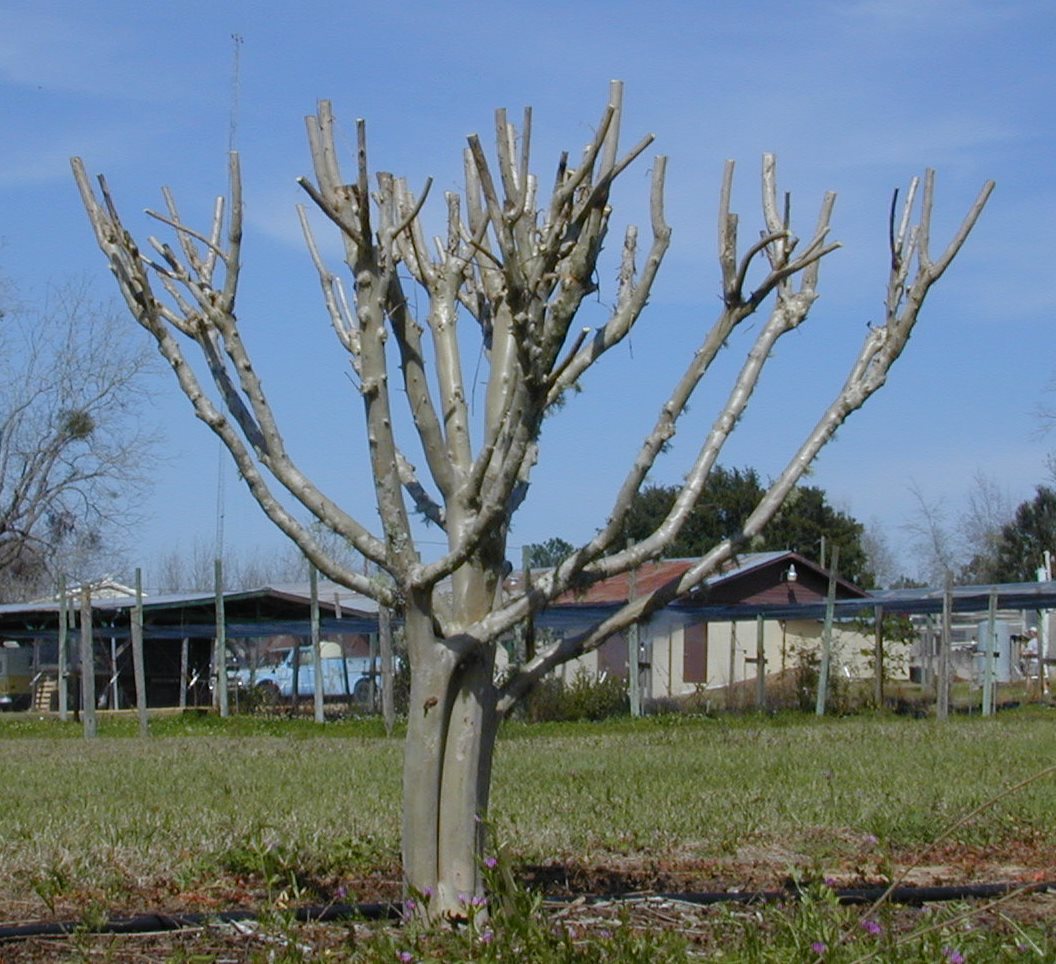
by Gary Knox | Jun 23, 2015
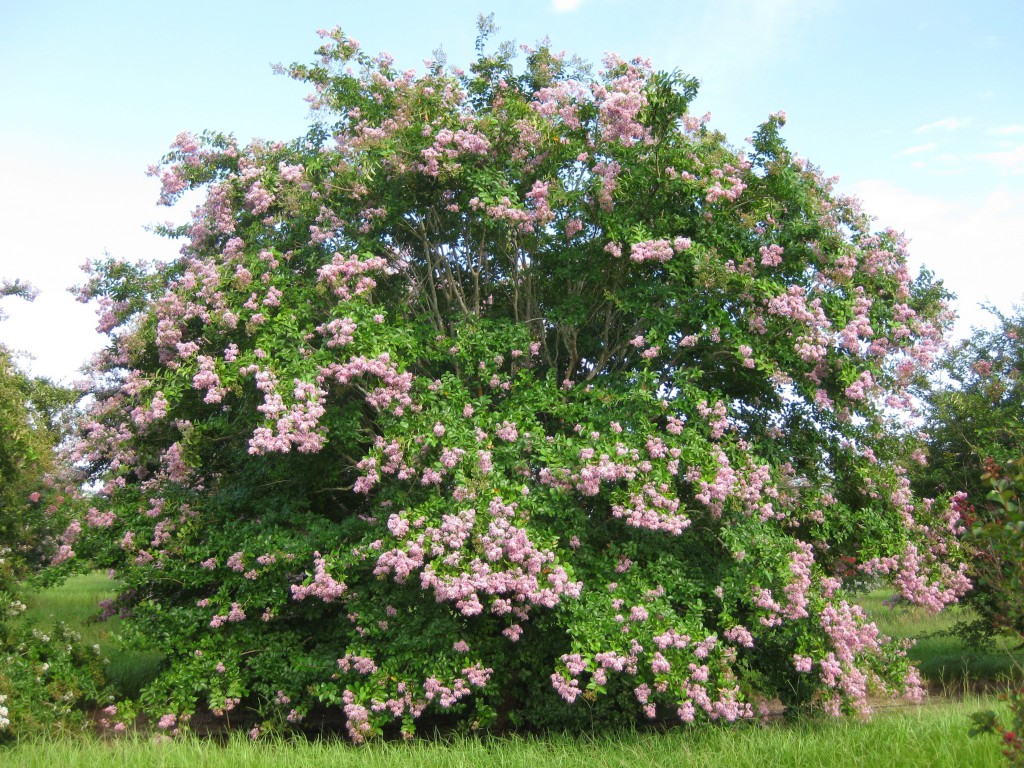
Figure 3. With proper cultivar selection and placement in the landscape, crapemyrtle develops into a beautifully shaped tree that rarely needs pruning. This crapemyrtle is ‘Muskogee’. Image Credit Gary Knox
Crapemyrtle flowering is set to be spectacular this year! While most other garden plants droop from summer’s heat, humidity and heavy rains, crapemyrtle thrives and puts on an outstanding show of flowers all summer and fall. Thanks to modern breeders, we have all sizes of improved hybrid crapemyrtles with flower colors of lavender, purple, white, pink, or red.
Just say “No” to Pruning
Crapemyrtle varieties come in tree-size, patio tree and shrub categories. Tree-size crapemyrtles grow 25 ft. tall and are ideal as flowering trees. Patio tree-form plants (up to 12 ft.) are beautiful as small, flowering specimen plants near patios, walkways, and entrances. Shrub forms (up to 6 ft.) make excellent accents in a shrub border and smaller types are effective as large groundcovers or container plants. Make sure you buy the right size crapemyrtle for your home. Don’t make the mistake of planting a tree-size crapemyrtle in an area too small for its ultimate size, or you’ll find yourself pruning it hard – and often – to keep it from out-growing its place.
Recommended Varieties
Some of the best tree-size (25 ft.) types are Natchez (white), Red Rocket® (red), Sioux (pink) and Apalachee (lavender). Superior patio tree crapemyrtles (12 ft.) are Acoma (white), Cheyenne (true red), Tonto (fuchsia red), Hopi (pink) and Catawba (purple). Smaller shrub (6 ft.) crapemyrtles are hard to find, but Cherry Dazzle® is a nice mounding red and Pixie White and New Orleans (purple) are good selections.
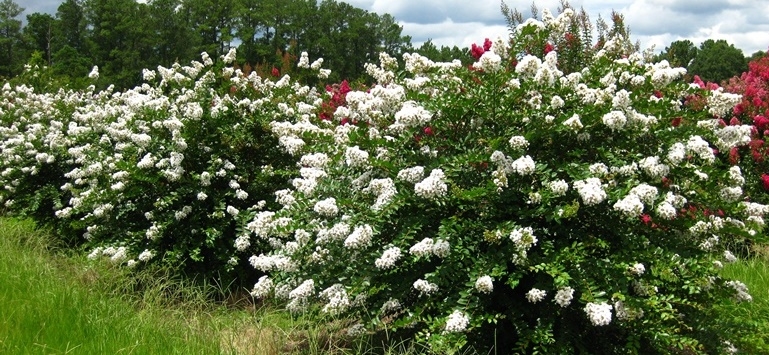
Planting and Garden Care
When it comes to planting, crapemyrtle is very tolerant and forgiving with three exceptions. Firstly, crapemyrtle needs sun to flower freely, so plant it in a site receiving at least six hours of direct sunlight each day. Secondly, crapemyrtle will not grow in wet soils. Finally, never plant crapemyrtle too deep — if you do so, it will punish you by not flowering for years and years. Planting too deep literally smothers the roots, requiring the crapemyrtle to regenerate a new root system in the soil above.
Crapemyrtle is very drought tolerant and almost seems to thrive on neglect. On the other hand, regular watering and fertilizer will help crapemyrtle grow faster and bigger.
More Beauty on the Way!
Breeders are continuing to improve and introduce new crapemyrtles. Many new varieties were released in the last couple years. In particular, watch for new types with purple-burgundy leaf color all summer long! Time will tell which new ones grow best in our area. Stay tuned as the world of crapemyrtle continues to evolve and improve!
*Gary Knox is Professor of Environmental Horticulture with the University of Florida. He is stationed at the North Florida Research and Education Center in Quincy, where he evaluates more than 100 cultivars of crapemyrtle.
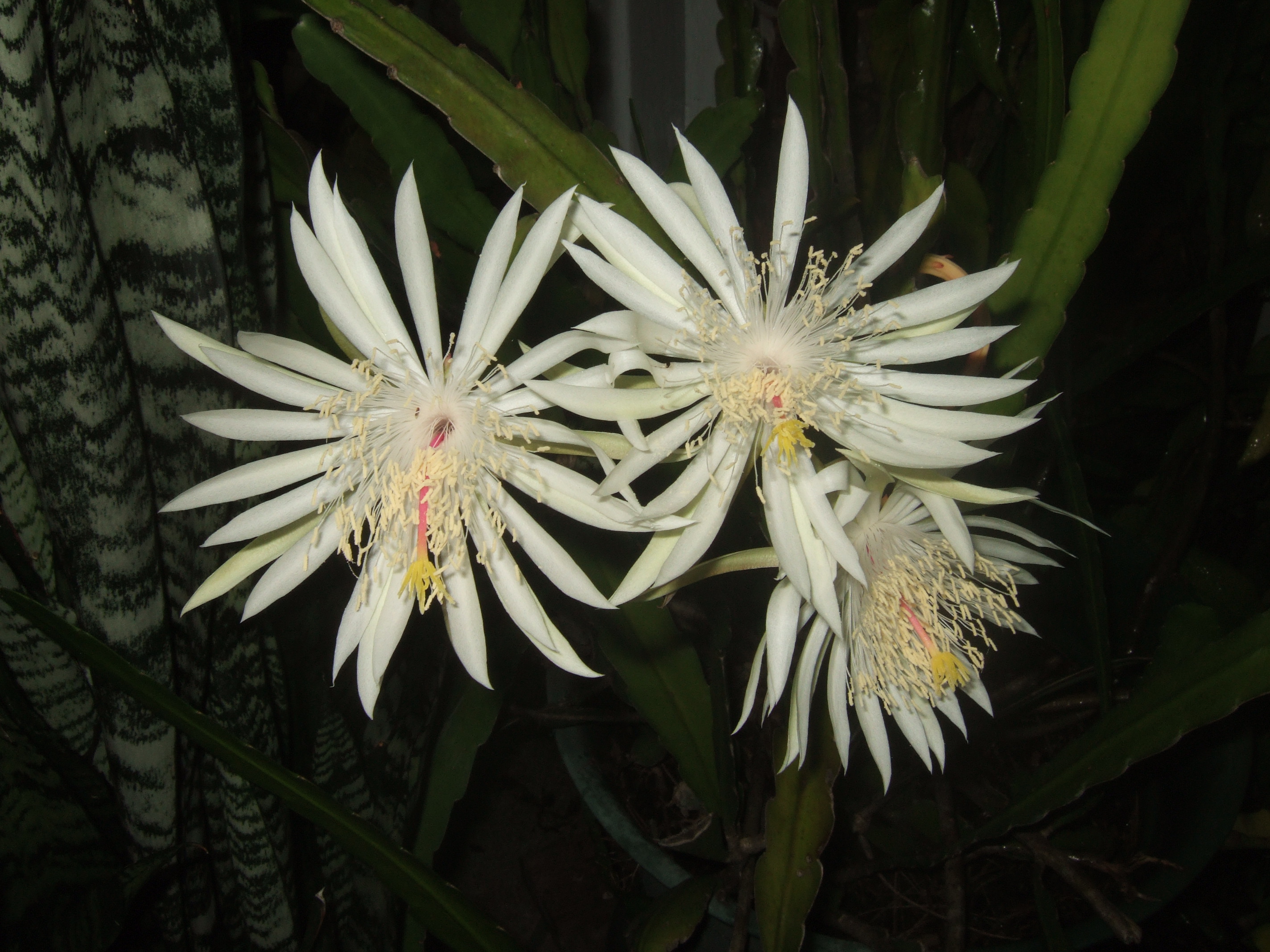
by Mary Salinas | Jun 23, 2015
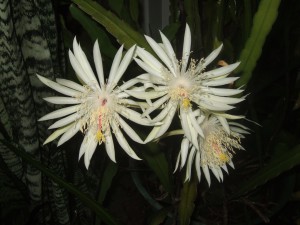
Night blooming cereus makes a stunning display. Photo credit: Sally Menk, Florida Master Gardener.
Many of us are working during the day and are not enjoying our gardens during the daytime. And maybe it is just too warm in the summer to be outside during the heat of the day. That leaves us to enjoy our gardens later in the day when the sun fades and evening approaches.
As the sunlight diminishes, the bright colors fade slowly to a black, gray and white world. The first colors to fade are the blues, purples and reds. Pastel pinks, yellows, oranges, grays and blues remain more visible for a longer time and take on a luminescent quality in the pale light. White blossoms now have their time to shine as they stand out against the darker hues of foliage and flowers.
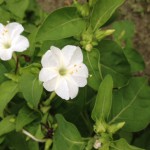
White four o’clock. Photo credit: Sandra Sherman, Florida Master Gardener.
If you find that your time in the garden is late in the day and into the evening, consider planning for that in your plant selections.
Here are some suggestions when planning your twilight garden:
- Add some late-afternoon and night-blooming plants such as four o’clocks, moonflower and night-blooming cereus
- Plants with silvery gray or white foliage glimmer in the moonlight. Consider white caladium, lamb’s-ears, silvery agaves, dusty miller and licorice plant among others. The white in variegated leaves of plants such as pentas, hosta, ginger and dogwood will stand out when dark green leaves have faded into the darkness.
- The tranquil sounds of a fountain will enhance end of the day relaxation.
- And, of course, add plants with white or pastel-colored flowers. The effect will be enhanced when luminous white blossoms are at different levels; for instance white spider lilies near the ground, white roses at eye level and white sparkleberry high above.
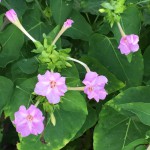
Pastel four o’clock opens late in the day. Photo credit: Linda Griffin, Florida Master Gardener.













